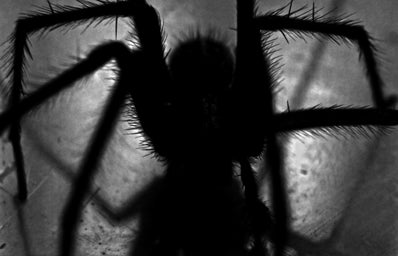Disclaimer: This article will primarily focus on spiders, specifically Tarantulas. It will feature descriptions as well as GIFs of Tarantulas. If you suffer from severe arachnophobia, this is not the article for you. Additionally, the author is an experienced Tarantula keeper – please do not attempt to hold or touch a Tarantula without a professional or experienced keeper present.
Hairy beast from hell or little fluffy friend?
There is no denying that the topic of Tarantulas isn’t a controversial one. Despite the fact that they are extremely fascinating creatures, you either love them or you hate them. As a Tarantula keeper myself, I only look at my little ones and see a cute fluffy angel. It can be extremely difficult for me to demonise them in the slightest, after all, they’ve given me no reason to. However, it wasn’t until a recent conversation with my flatmate that I remembered this isn’t the same for everyone.
“You need to put a trigger warning on that”, she said as I posted a day in the life Tik Tok for Her Campus Brighton. I was taken aback, what did she mean by “put a trigger warning on that”? What was so triggering about my university books and bedroom, I thought. It wasn’t until I watched the Tik Tok for the third time trying to spot the problem that I realised she meant the fact that I had showcased one of my Tarantulas – Cuthbert, my Green Bottle Blue baby. It was then that I remembered that not everyone is going to look at him in awe and think he’s the cutest little thing they’ve ever seen; that 45% of Brits would look at him and scream bloody murder and have nightmares for days on end.
Do I blame people for being afraid of them? Well, not really. The demonisation of Tarantulas and spiders, in general, has become so normalised in society it’s basically a natural instinct. For example, there has not been a single movie that features Tarantulas that doesn’t use them to horrify its audience. From movies such as Tarantula (1985) to Arachnophobia (1990) and Eight Legged Freaks (2002) depicting them as crazy mutated beasts, a trope which also bleeds into famous works of literature such as The Lord of The Rings (1954) with the demon Shelob; it becomes clear that there has been no accurate representation of these clever Arachnids. In addition to this, viral news stories about Tarantulas dominating social media platforms with adjectives such as ‘terrifying’ plastering the headlines does nothing but serve as sensationalism to keep the unjust narrative in place.
So what do we fellow Tarantula lovers like myself do when everyone around us hates the thing we care for the most? We educate them. Or, in my case, I sent out a short survey for Her Campus Brighton members to fill out and at the end, I asked them to send me myths about Tarantulas to debunk in this article. I have narrowed down these myths to the most common ones, and I will be spreading the truth about my little furry friends in the hopes that you may grow to love them too.
Myth #1: Tarantulas can kill you.
This myth is by far the most common piece of misinformation that spreads about Tarantulas, and you’ll be surprised how many people believe it to be true. The reality is that there has been no recorded human death at the hand of a Tarantula. While Tarantulas do carry venom, this venom is very low in toxicity for humans. However, the pain levels of the venom are dependent on the species of the Tarantula. For example, New World species that are typically found in North and South America typically stick to a diet of small lizards, mice and other insects. Because of this, they have evolved in a way where their venom is most effective towards their prey, so to us, their venom would have the same effect as a bee or wasp sting. On the other hand, there are Old World species that are typically found in Africa, Asia and Australia (for example, the Baboon spider), which rely solely on their venom to protect them from much larger predators. As you can imagine, a small Tarantula that needs to protect itself from animals such as Monkeys is going to pack one hell of a punch with its venom, so a human being bit by one is going to cause some fairly painful symptoms such as cramping and nausea, but still not enough to cause death or long-term health problems.
MYth #2: tARANTULAS BITE FOR NO REASON.
This is a myth that causes me severe annoyance, as a majority of times where someone has been bitten by a Tarantula it has been that individuals fault. While there is such a thing as an aggressive Tarantula, their mission in life isn’t to bite us or cause us harm – it’s to protect themselves. Additionally, nine times out of ten a Tarantula, regardless of its species, will always give you warning signs before it goes in for the attack. New World species such as the Giant White Knee or Mexican Red Knee are armed up with little urticating hairs on their abdomen and back legs which they tend to kick at you if you disturb them. The complications from these hairs can range from rashes on the skin, itchiness and inflammation of the eyes and nasal passages, which is why it’s best to keep them away from your face. However, washing your hands and taking an antihistamine can help to relieve these symptoms. It is very unlikely that a New World species will bite you, and as a keeper who only owns New World species, I can say that I have only had hairs kicked at me once with my Tarantulas being docile a good 90% of the time. Old World species on the other hand do not have urticating hairs, and as mentioned previously, rely on their bite to protect themselves from predators. This isn’t to say that you’ll be bit instantly, as they too also have warning signs such as rearing up their front legs into a threat pose and species such as the King Baboon creating a hissing sound (stridulating). However, there are keepers of Old Word species who have never been bitten, as treating your Tarantula with respect and using appliances such as tongs when entering their enclosure will keep you safe from a territorial and annoyed Arachnid.
MYTH #3: You can hold a tarantula at any age.
Technically, this one shouldn’t count as a myth, but it is widely acknowledged in the Tarantula community that you shouldn’t handle them at all. I for one, have never held my Tarantulas. This isn’t because they are dangerous to me, I’ve debunked those myths already, but it’s because they are incredibly fragile and unpredictable creatures. A Tarantulas abdomen is so fragile that if it was dropped from even a few centimetres from the ground, it could rupture and kill the Tarantula. While some people may swear they’re careful enough to handle a Tarantula and not drop it, this isn’t always the case. A Tarantula can get spooked by things as small as you blowing air near them, which can cause them to bolt away from what is scaring them which ultimately can shock the handler and make them drop it (this is a natural instinct of humans, after all). Therefore, it isn’t advised, but there are times where you may have to handle them such as rehousing them into a new enclosure. In this instance, it’s best to grab a small paintbrush and lightly tap the Tarantulas abdomen with the bristles to either guide it onto your hand or tub to transport it into its new home.
Myth #4: Tarantulas run and jump at humans.
Absolutely not. This is probably the funniest Tarantula myth of them all, as all they want to do is get away from us when threatened – not towards us. While a Tarantula can run incredibly fast (between 8.4 to 21 inches per second), it’s not every day where you’ll see one activate its super-speed. In fact, a majority of the time Tarantulas don’t move that much at all and when they do it’s very slow. I actually think that being a Tarantula keeper has taught me more about patience than any other animal, as the only time I’ve seen mine move fast is to catch a Cricket. A Tarantula will only run fast if it acts in its best interest, such as catching prey or escaping a predator, therefore these bursts of energy are incredibly short-lived. Tarantulas need to preserve their energy, not waste it, so you won’t catch them doing 100-metre sprints at you anytime soon. Additionally, the idea that Tarantulas would jump feet into the air to attack a human is even funnier to me. These creatures aren’t Olympic Athletes. While there are some species of Tarantula such as the Guyana Pink Toe which can potentially jump short distances between tree branches, they are not going to risk their lives jumping to a height that is potentially fatal to them. Also, a Tarantula can’t even jump vertically.
Still scared of Tarantulas?
Well, that’s okay. Outgrowing a fear isn’t going to happen overnight, but I hope that this article has educated you somewhat to an extent and you can begin to understand how misunderstood these creatures truly are. In fact, at some point in the future Tarantulas will actually prove to be very beneficial for humans, with a peptide in Tarantula venom being considered as a treatment for muscular dystrophy. While there are species of spider out there such as the Wandering Spider or Funnel Web that can cause severe health complications and can even kill humans, they aren’t demonised or spoken about half as much as Tarantulas are. But although there are more dangerous spiders out there, you are still more likely to die in your own bathtub than from an encounter with an eight-legged geek.




